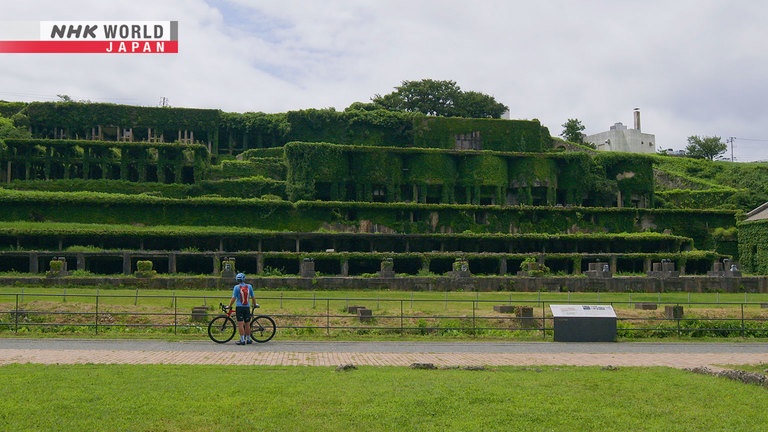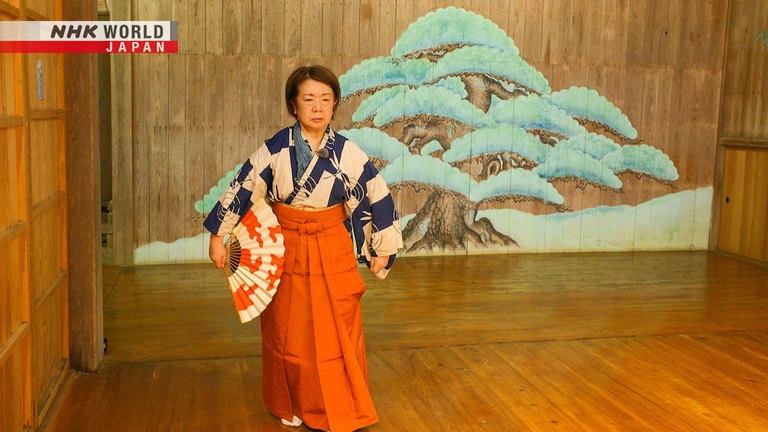Sado - Island of Hidden Treasures
Historically Japan was famous for gold, much of it mined on Sado. The prosperity this created left the island with unique cultural traditions like its strong Noh theater. We meet an actor teaching a new generation of Noh performers, cycle Sado's beautiful coastline and spectacular mountains, paddle hangiri shallow-water fishing boats, and meet the man who rescued the Japanese crested ibis from extinction to Sado's current population of 500 birds.




Transcript
The best way to discover little-known sights and make even familiar places feel brand new,
is to go exploring by bicycle.
Today we're visiting Sado Island, home to around 50,000 people.
This island was once the source of immense wealth, thanks to its rich gold deposits.
Wealth that nurtured a number of cultural traditions, many of which still thrive today.
Everyone needs a foundation,
a support to help them through life.
This voyage of discovery will get pretty physical at times.
I had to be rescued.
Exploring life on Sado today, we'll see
how deeply it's still inspired by the island's past.
Sado is an isolated island off the west coast of Japan.
And this is the first time I've come close to the island.
It's much bigger than I thought it was.
Hi, it's Paul again, starting another tour for Cycle Around Japan.
Paul Imperatrice is from New Zealand.
A fascination with Asian culture brought him to Japan in 1991.
He runs his own language school in Tokyo.
Paul sets off from Ryōtsu Port, the gateway to Sado for visitors.
Off on another great adventure.
Well, that sea is really beautifully clear.
Vivid blue, and green mountains.
The Sea of Japan being a lot smaller than the Pacific, but it's amazingly blue.
Paul begins with a circuit of the island, following the coast.
Beautiful rocks.
Unbelievable. Absolutely unbelievable.
And there's no one here.
Oh, they're growing rice, right down to the sea's edge.
Oh look, there's some small boat-type thing.
Oh, that's really weird.
- Good morning!
- Hello!
What is that boat?
It's called a hangiri, or rice tub,
because that's what they were made from.
They were invented to fish for turban shells
and abalone.
Hangiri have been used here for a long time.
They were originally made by cutting large wooden tubs in half.
The islanders invented this kind of boat
so they could fish in very shallow coastal waters.
- I made this one myself. Come aboard!
- Looks amazing.
Don't worry if it leaks a bit.
Kaneko Keiji is a skilled maker of hangiri.
He uses them to take visitors on trips to explore Sado's coast.
Here we go!
These shallow coastal waters are the result of an earthquake
that caused the seafloor to rise over 200 years ago.
These waters became too shallow for boats,
so they cut wooden tubs in half to use instead.
While working for a pleasure boat company,
Kaneko taught himself how to construct hangiri.
These boats, so familiar since his childhood,
were on the verge of disappearing as less people were fishing.
He started giving tours in the hangiri he built,
which quickly became a must-do item for visitors to the island.
Now I'll teach you how to paddle the boat.
Hangiri use a unique paddling technique.
Watch carefully how I do it.
From neutral, I'll first go right. I angle the paddle
45 degrees and push to the right.
Now back to neutral, 45 degrees,
push to left. Give it a try.
This is gonna be fun.
- Hello there!
- Hello!
This is Izawa Ayaka. She's new at this,
only been doing it two years.
To help Paul enjoy the hangiri experience,
Kaneko has invited his favorite assistant to help.
To Paul's surprise, Kaneko decides they'll have a race.
Ready! Go! Go!
I'm heading in the wrong direction.
Where am I going?
Paul! What are you doing?
That was exhausting.
I had to be rescued.
I'm so tired I can't paddle any more.
I have fun, meet all sorts of people
as I introduce them to nature.
Working the hangiri boats was how I met Ayaka,
and now I've met Paul too.
For me, the hangiri is an amazing tool
to bring people together.
- Hangiri power.
- Hangiri power!
An island tradition, reborn for today.
Beautifully clear.
Paul has heard that a nearby hill has a spectacular view of the ocean, so he heads inland.
The first thing he passes are rice paddies.
Amazing. They've gone to all this effort up the top of this hill
to find this little amount of flat land,
and they've put it to use like this.
It's like a jigsaw puzzle.
Oh man, this is steep.
Oh dear.
This looks like a good place to stop. Wow.
That is incredible. Look at that.
Lime green through the dark green and off into the deep, blue sea.
Paul is now in the central part of the island,
where there's something special he wants to see.
There we go.
Oh, here he is.
Very quick work. Wow, they make really quick work of getting one of those.
Sado Island is the only place in Japan where the crested ibis can be found today.
This facility breeds and helps conserve these rare birds.
These two were just born this year.
How old are they now?
- They were born in May, so two months.
- Amazing how big they've grown.
Veterinarian Kaneko Yoshinori was the first person in Japan to successfully breed a crested ibis in captivity.
Until the 19th century, crested ibis were common throughout Japan,
but overhunting and environmental degradation led to their extinction.
Kaneko and his colleagues imported a mating pair from China,
but it proved extremely difficult getting them to breed.
When a chick was finally born in 1999,
they had to figure out everything by trial and error.
I didn't know anything about raising them,
not even the kind of food they'd need.
So when the first was born, I was in a cold
sweat wondering how to look after it.
The mildest stomach upset kept me up all night.
The pressure was tremendous.
By 2008, their breeding program was successful
and they were able to release 10 crested ibis into the wild.
The birds continued to increase in number,
and today there are more than 500 living around Sado Island.
The islanders themselves have played a large part in ensuring the return of Sado's ibis population.
Kaneko takes Paul to meet one of them, farmer Saito Shinichiro.
When we lost all our ibis before, it was agriculture
that put the final nail in their coffin.
The overuse of pesticides killed off their food,
so they couldn't survive.
I farm using minimal pesticides,
to help the ibis population continue to recover.
Crested ibis eat insects, frogs and other small creatures.
Reduced chemical use allowed rice paddy ecosystems to recover
and once again provide plentiful food for the ibis.
One of the older farmers told me about
the beauty of the crested ibis in the sunset sky.
We're all happy to change our farming methods
if we can bring those days back.
In the old days, there were so many the farmers saw
them as pests that harmed their crops.
We're a long way from having that problem again.
I hope to be remembered as the one
who brought the ibis back.
Sado Island rice is gaining popularity nationwide as an eco-friendly brand.
Back on the coast road, Paul is now approaching the northern end of the island,
where he'll face his biggest challenge.
I've finally come to the "Z Switchback," something all us cyclists know about.
It gets its name from the way it looks like a letter "Z" when seen from below.
Paul will climb about 130 meters on this short stretch of road.
I can't remember what part of the letter I'm up to now.
Again.
Another switchback.
Oh, we're heading into the tunnel.
Woah.
That's seriously high.
Straight off.
Riding inland again, Paul spots something interesting.
This is a pretty established building.
I'll just drop in.
I'm not sure if it's...
It sort of looks like a temple.
What a beautiful building.
Wow, that's a stage.
Noh theater stage.
Oh, hello!
I hope you don't mind,
but this place looked so beautiful.
- My name is Paul.
- I'm Saito Michie.
Saito Michie is a Noh performer.
Noh is a classical form of Japanese dance-drama in which actors wearing masks sing or chant their lines.
Noh became immensely popular on Sado in the 17th century,
and has been a favorite entertainment of the islanders ever since.
There are still around 30 Noh stages on the island; the plays performed by local amateurs.
Saito's life has revolved around Noh since she was in her twenties.
While working and raising a family, she continued to perfect her art,
becoming a Noh teacher at the age of 64.
She still plays leading roles.
Getting married, raising children, life is hard.
Noh helped me throughout - the challenge of
mastering a fresh story and character every year.
We all need a strong support to see us through life,
and for me Noh has been that pillar.
There's one activity Saito currently focuses much of her energy on.
This is the Noh class she teaches at a local elementary school.
Turn the fan out, then bring it back to your chest.
And round your arms a bit more.
The number of performers has declined as the population ages,
and Saito hopes these children will ensure the future of the island's Noh tradition.
- What did you play today?
- I was a drunken demon.
- Was that fun?
- It was great!
They're all so serious about practicing.
The children are very committed, and I'm happy
to see them get good enough for the stage.
It gives me great pleasure to see the future
of Noh on Sado in these kids.
Saito's greatest role might be to save the tradition of her island birthplace.
Paul is now getting close to his goal.
Oh man, this hill just goes on forever.
The Sado people, maybe because it's an island,
maybe because they have a limited area and also a limited population
but they've all worked together to utilize what they have here,
the beautiful nature, the longstanding culture.
Sado, for me, has become a real jewel in the Nihon Sea, in the Sea of Japan.
I did it! I really didn't think I was going to make that one.
I really didn't think I had it in me to do that.
I decided to die trying.
I'm so glad I didn't stop.
That was as much as I could do.
A fine end. A fine end to a beautiful trip.
I recommend everyone should come to Sado and enjoy it for its nature and its culture.
You won't be disappointed.
I will definitely come back here for more.
An island of treasures, cultural and natural gems that will shine
as long as there are people here on Sado to treasure and care for them.